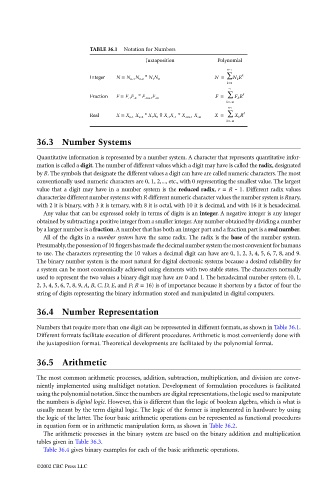Page 1033 - The Mechatronics Handbook
P. 1033
TABLE 36.1 Notation for Numbers
Juxtaposition Polynomial
n-1
∑ k
Integer N = N n-1 N n-2 º N 1 N 0 N = N k R
k=0
-1
∑ k
Fraction F = F -1 F -2 º F -m+1 F -m F = F k R
k=-m
n-1
∑ k
Real X = X n-1 X n-2 º X 1 X 0 ◊ X -1 X -1 º X -m+1 X -m X = X k R
k=-m
36.3 Number Systems
Quantitative information is represented by a number system. A character that represents quantitative infor-
mation is called a digit. The number of different values which a digit may have is called the radix, designated
by R. The symbols that designate the different values a digit can have are called numeric characters. The most
conventionally used numeric characters are 0, 1, 2,..., etc., with 0 representing the smallest value. The largest
value that a digit may have in a number system is the reduced radix, r = R - 1. Different radix values
characterize different number systems: with R different numeric character values the number system is Rnary,
with 2 it is binary, with 3 it is ternary, with 8 it is octal, with 10 it is decimal, and with 16 it is hexadecimal.
Any value that can be expressed solely in terms of digits is an integer. A negative integer is any integer
obtained by subtracting a positive integer from a smaller integer. Any number obtained by dividing a number
by a larger number is a fraction. A number that has both an integer part and a fraction part is a real number.
All of the digits in a number system have the same radix. The radix is the base of the number system.
Presumably, the possession of 10 fingers has made the decimal number system the most convenient for humans
to use. The characters representing the 10 values a decimal digit can have are 0, 1, 2, 3, 4, 5, 6, 7, 8, and 9.
The binary number system is the most natural for digital electronic systems because a desired reliability for
a system can be most economically achieved using elements with two stable states. The characters normally
used to represent the two values a binary digit may have are 0 and 1. The hexadecimal number system (0, 1,
2, 3, 4, 5, 6, 7, 8, 9, A, B, C, D, E, and F; R = 16) is of importance because it shortens by a factor of four the
string of digits representing the binary information stored and manipulated in digital computers.
36.4 Number Representation
Numbers that require more than one digit can be represented in different formats, as shown in Table 36.1.
Different formats facilitate execution of different procedures. Arithmetic is most conveniently done with
the juxtaposition format. Theoretical developments are facilitated by the polynomial format.
36.5 Arithmetic
The most common arithmetic processes, addition, subtraction, multiplication, and division are conve-
niently implemented using multidiget notation. Development of formulation procedures is facilitated
using the polynomial notation. Since the numbers are digital representations, the logic used to maniputate
the numbers is digital logic. However, this is different than the logic of boolean algebra, which is what is
usually meant by the term digital logic. The logic of the former is implemented in hardware by using
the logic of the latter. The four basic arithmetic operations can be represented as functional procedures
in equation form or in arithmetic manipulation form, as shown in Table 36.2.
The arithmetic processes in the binary system are based on the binary addition and multiplication
tables given in Table 36.3.
Table 36.4 gives binary examples for each of the basic arithmetic operations.
©2002 CRC Press LLC

